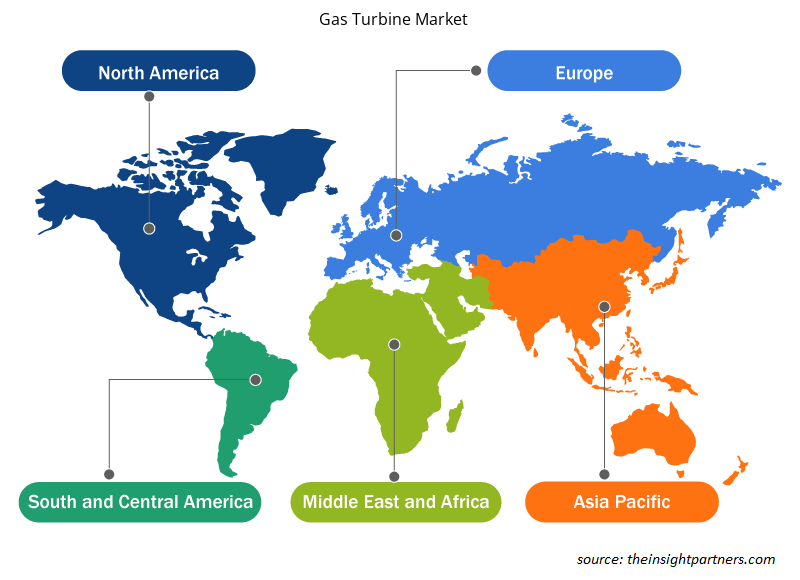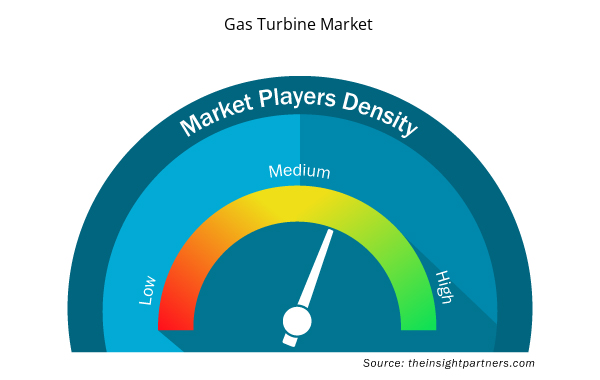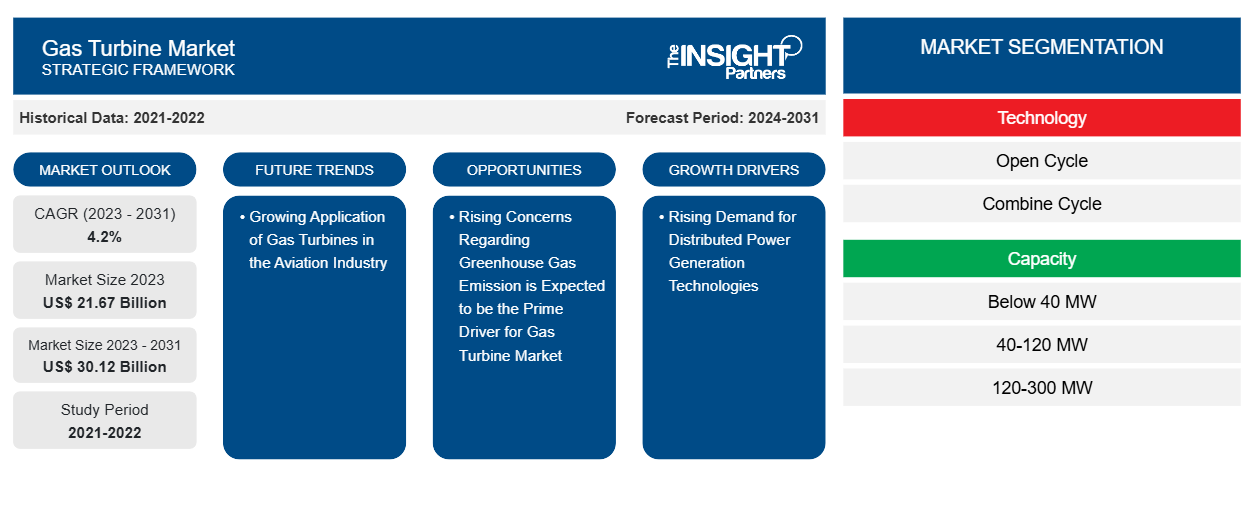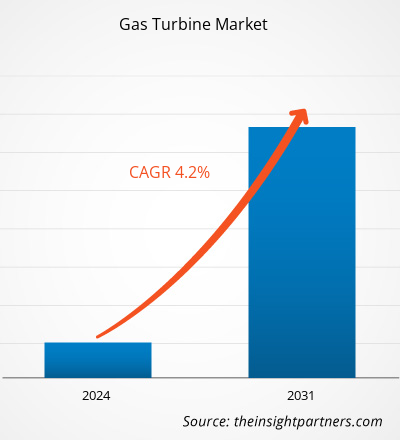Der Gasturbinenmarkt soll von 21,67 Milliarden US-Dollar im Jahr 2023 auf 30,12 Milliarden US-Dollar im Jahr 2031 anwachsen. Der Markt soll zwischen 2023 und 2031 eine durchschnittliche jährliche Wachstumsrate (CAGR) von 4,2 % verzeichnen. Weitere Trends für den Gasturbinenmarkt sind der wachsende technologische Fortschritt im Energiesektor und die steigende Nachfrage nach dezentralen Stromerzeugungstechnologien.CAGR of 4.2% in 2023–2031. Growing technological advancement in the energy sector and rising demand for distributed power generation technologies are some other trends for the Gas Turbine Market.
Gasturbinenmarktanalyse
Steigende Umweltbedenken und ein wachsender Energiebedarf sind einige der Hauptfaktoren, die die Nachfrage nach Gasturbinen weltweit ankurbeln. Auch die zunehmende staatliche Förderung von Stromerzeugungstechnologien, die auf geringere Kohlenstoffemissionen abzielen, wirkt sich als wichtiger Markttreiber aus. Die Abkehr der Verbraucher von der kohlebasierten Stromerzeugung hin zu gasbetriebenen Verfahren ist einer der Haupttrends, die voraussichtlich die Entwicklung des Gasturbinenmarktes im Prognosezeitraum vorantreiben werden.
Überblick über den Gasturbinenmarkt
Mit der wachsenden Bevölkerung und der raschen Industrialisierung steigt auch der Energiebedarf weltweit. Gasturbinen sind viel umweltfreundlichere Optionen zur Stromerzeugung und wirken als wichtiger Wachstumsfaktor für den Gasturbinenmarkt. Im Vergleich zu anderen verbrennungsbetriebenen Stromerzeugungstechnologien sind Gasturbinen leistungsfähiger und stoßen weniger Kohlenstoff aus. Die Umsetzung mehrerer Initiativen zum Klimawandel sowie die Umsetzung von Vorschriften zur Reduzierung der Treibhausgasemissionen werden voraussichtlich die Nachfrage nach Gasturbinen im Prognosezeitraum ankurbeln.GHG emissions, are anticipated to push the demand for gas turbines during the projected period.
Passen Sie diesen Bericht Ihren Anforderungen an
Sie erhalten kostenlos individuelle Anpassungen an jedem Bericht, einschließlich Teilen dieses Berichts oder einer Analyse auf Länderebene, eines Excel-Datenpakets sowie tolle Angebote und Rabatte für Start-ups und Universitäten.
- Holen Sie sich die wichtigsten Markttrends aus diesem Bericht.Dieses KOSTENLOSE Beispiel umfasst eine Datenanalyse von Markttrends bis hin zu Schätzungen und Prognosen.
Treiber und Chancen auf dem Gasturbinenmarkt
Zunehmende Bedenken hinsichtlich der Treibhausgasemissionen dürften der Haupttreiber für den Gasturbinenmarkt sein
Gasturbinen gelten als umweltfreundlichere Alternative zur Stromerzeugung als kohlebetriebene Technologien. Das wachsende Bewusstsein für den Umweltschutz und die wachsende Nachfrage nach fortschrittlicheren Stromerzeugungstechnologien, die zudem weniger schädliche Auswirkungen auf die Umwelt haben, kurbeln das Wachstum des Marktes weltweit an. Die zunehmende Umweltverschmutzung aufgrund der raschen Industrialisierung und der Nutzung fossiler Brennstoffe zur Stromerzeugung sind einige der Hauptprobleme, die die Verbrauchernachfrage nach Gasturbinen antreiben. Die zunehmenden staatlichen Initiativen zur Förderung umweltfreundlicherer Stromerzeugungstechnologien für verschiedene Branchen wie Öl und Gas, Chemie und Fertigung, um nur einige zu nennen, mit dem Ziel, die Treibhausgasemissionen zu verringern, wirken als Haupttreiber für den Gasturbinenmarkt.
Zunehmender Einsatz von Gasturbinen in der Luftfahrtindustrie
Die zunehmende Verbreitung von Gasturbinen in der Luftfahrtindustrie ist eine der Wachstumschancen für den Markt. Gasturbinen sind für ihr Leistungsgewichtsverhältnis bekannt, was sie zu einem geeigneten Antriebssystem für Flugzeuge macht. Gasturbinen sind auch bei der Stromerzeugung effizient, was ebenfalls Chancen für den Gasturbinenmarkt bieten dürfte.
Segmentierungsanalyse des Gasturbinenmarktberichts
Schlüsselsegmente, die zur Ableitung der Gasturbinenmarktanalyse beigetragen haben, sind Technologie, Kapazität und Anwendung.
- Basierend auf der Technologie wurde der Markt in offene Kreisläufe und kombinierte Kreisläufe unterteilt. Das Segment der kombinierten Kreisläufe hatte im Jahr 2023 einen größeren Marktanteil.
- In Bezug auf die Kapazität wurde der Markt in Unter 40 MW, 40–120 MW, 120–300 MW und Über 300 MW segmentiert. Das Segment 120–300 MW dominierte den Markt im Jahr 2023.
- In Bezug auf die Anwendung wurde der Markt in Stromerzeugung, Öl und Gas sowie Industrie segmentiert. Das Segment Stromerzeugung dominierte den Markt im Jahr 2023.
Gasturbinen-Marktanteilsanalyse nach geografischer Lage
Der geografische Umfang des Gasturbinenmarktberichts ist hauptsächlich in fünf Regionen unterteilt: Nordamerika, Europa, Asien-Pazifik, Naher Osten und Afrika sowie Südamerika.
Der asiatisch-pazifische Raum dominierte den Gasturbinenmarkt im Jahr 2023. Der asiatisch-pazifische Raum umfasst Australien, China, Indien, Japan und Südkorea. Die wachsende Bevölkerung und der steigende Energiebedarf wirken als wichtige Wachstumsfaktoren für den Markt im asiatisch-pazifischen Raum. Darüber hinaus wird erwartet, dass der zunehmende Fokus der Regierung auf den Einsatz unterstützender Richtlinien und Maßnahmen zur Verringerung der Abhängigkeit von fossilen Brennstoffen zur Senkung der Kohlenstoffemissionen das Wachstum des Marktes im asiatisch-pazifischen Raum lenken wird. China ist ein bemerkenswerter Akteur im asiatisch-pazifischen Raum, gefolgt von Indien, Japan und Australien im Jahr 2023. Die hohe Präsenz von Gasturbinenakteuren im asiatisch-pazifischen Raum wirkt als wichtiger Treiber für den Markt im asiatisch-pazifischen Raum. Schnelle Industrialisierung, zunehmende Urbanisierung und steigender Energiebedarf sind einige der Hauptfaktoren, die das Wachstum des Marktes im asiatisch-pazifischen Raum ankurbeln.
Regionale Einblicke in den Gasturbinenmarkt
Die regionalen Trends und Faktoren, die den Gasturbinenmarkt im Prognosezeitraum beeinflussen, wurden von den Analysten von Insight Partners ausführlich erläutert. In diesem Abschnitt werden auch die Marktsegmente und die Geografie des Gasturbinenmarkts in Nordamerika, Europa, im asiatisch-pazifischen Raum, im Nahen Osten und Afrika sowie in Süd- und Mittelamerika erörtert.

- Erhalten Sie regionale Daten zum Gasturbinenmarkt
Umfang des Gasturbinenmarktberichts
| Berichtsattribut | Details |
|---|---|
| Marktgröße im Jahr 2023 | 21,67 Milliarden US-Dollar |
| Marktgröße bis 2031 | 30,12 Milliarden US-Dollar |
| Globale CAGR (2023 - 2031) | 4,2 % |
| Historische Daten | 2021-2022 |
| Prognosezeitraum | 2024–2031 |
| Abgedeckte Segmente | Nach Technologie
|
| Abgedeckte Regionen und Länder | Nordamerika
|
| Marktführer und wichtige Unternehmensprofile |
|
Marktteilnehmerdichte: Der Einfluss auf die Geschäftsdynamik
Der Gasturbinenmarkt wächst rasant, angetrieben durch die steigende Endverbrauchernachfrage aufgrund von Faktoren wie sich entwickelnden Verbraucherpräferenzen, technologischen Fortschritten und einem größeren Bewusstsein für die Vorteile des Produkts. Mit steigender Nachfrage erweitern Unternehmen ihr Angebot, entwickeln Innovationen, um die Bedürfnisse der Verbraucher zu erfüllen, und nutzen neue Trends, was das Marktwachstum weiter ankurbelt.
Die Marktteilnehmerdichte bezieht sich auf die Verteilung von Firmen oder Unternehmen, die in einem bestimmten Markt oder einer bestimmten Branche tätig sind. Sie gibt an, wie viele Wettbewerber (Marktteilnehmer) in einem bestimmten Marktraum im Verhältnis zu seiner Größe oder seinem gesamten Marktwert präsent sind.
Die wichtigsten auf dem Gasturbinenmarkt tätigen Unternehmen sind:
- Ansaldo Energia SpA
- Allgemeine Elektrizit?tsgesellschaft
- Harbin Electric Company Limited
- Kawasaki Heavy Industries
- GmbH
Haftungsausschluss : Die oben aufgeführten Unternehmen sind nicht in einer bestimmten Reihenfolge aufgeführt.

- Überblick über die wichtigsten Akteure auf dem Gasturbinenmarkt
Neuigkeiten und aktuelle Entwicklungen auf dem Gasturbinenmarkt
Der Gasturbinenmarkt wird durch die Erhebung qualitativer und quantitativer Daten nach Primär- und Sekundärforschung bewertet, die wichtige Unternehmensveröffentlichungen, Verbandsdaten und Datenbanken umfasst. Im Folgenden finden Sie eine Liste der Entwicklungen auf dem Gasturbinenmarkt und der Strategien:
- Im April 2024 gab GE Vernovas Gas Power-Geschäft bekannt, dass es einen Auftrag von Korea Western Power Co., Ltd zur Lieferung eines GE Vernova H65-Generators und einer 7HA.02-Gasturbine für das Kraftwerk von KOWEPO in Gongju-si, Chungcheongnam-do, Republik Korea, erhalten hat. (Quelle: GE, Pressemitteilung/Unternehmenswebsite/Newsletter)
- Im Januar 2024 arbeiteten GE Vernova und IHI Corporation gemeinsam an einem Projekt zur Entwicklung eines neuen Gasturbinenbrenners, der voraussichtlich Ammoniak als praktikable Brennstoffoption für die Stromerzeugung nutzen kann und auch für die Gasturbinen 7F, 9F und 6F.03 von GE Vernova geeignet ist. (Quelle: GE, Pressemitteilung/Unternehmenswebsite/Newsletter)
Marktbericht zu Gasturbinen – Umfang und Ergebnisse
Der Bericht „Marktgröße und Prognose für Gasturbinen (2021–2031)“ bietet eine detaillierte Analyse des Marktes, die die folgenden Bereiche abdeckt:
- Marktgröße und Prognose auf globaler, regionaler und Länderebene für alle wichtigen Marktsegmente, die im Rahmen des Projekts abgedeckt sind
- Marktdynamik wie Treiber, Beschränkungen und wichtige Chancen
- Wichtige Zukunftstrends
- Detaillierte PEST-Analyse
- Globale und regionale Marktanalyse mit wichtigen Markttrends, wichtigen Akteuren, Vorschriften und aktuellen Marktentwicklungen
- Branchenlandschaft und Wettbewerbsanalyse, einschließlich Marktkonzentration, Heatmap-Analyse, prominenten Akteuren und aktuellen Entwicklungen
- Detaillierte Firmenprofile mit SWOT-Analyse
- Historische Analyse (2 Jahre), Basisjahr, Prognose (7 Jahre) mit CAGR
- PEST- und SWOT-Analyse
- Marktgröße Wert/Volumen – Global, Regional, Land
- Branche und Wettbewerbsumfeld
- Excel-Datensatz


- Animal Genetics Market
- Predictive Maintenance Market
- Hydrocephalus Shunts Market
- Virtual Production Market
- Arterial Blood Gas Kits Market
- Biopharmaceutical Contract Manufacturing Market
- Flexible Garden Hoses Market
- Hydrogen Storage Alloys Market
- Underwater Connector Market
- Saudi Arabia Drywall Panels Market

Report Coverage
Revenue forecast, Company Analysis, Industry landscape, Growth factors, and Trends

Segment Covered
This text is related
to segments covered.

Regional Scope
North America, Europe, Asia Pacific, Middle East & Africa, South & Central America

Country Scope
This text is related
to country scope.
Trends and growth analysis reports related to Energy and Power : READ MORE..
The Insight Partners performs research in 4 major stages: Data Collection & Secondary Research, Primary Research, Data Analysis and Data Triangulation & Final Review.
- Data Collection and Secondary Research:
As a market research and consulting firm operating from a decade, we have published and advised several client across the globe. First step for any study will start with an assessment of currently available data and insights from existing reports. Further, historical and current market information is collected from Investor Presentations, Annual Reports, SEC Filings, etc., and other information related to company’s performance and market positioning are gathered from Paid Databases (Factiva, Hoovers, and Reuters) and various other publications available in public domain.
Several associations trade associates, technical forums, institutes, societies and organization are accessed to gain technical as well as market related insights through their publications such as research papers, blogs and press releases related to the studies are referred to get cues about the market. Further, white papers, journals, magazines, and other news articles published in last 3 years are scrutinized and analyzed to understand the current market trends.
- Primary Research:
The primarily interview analysis comprise of data obtained from industry participants interview and answers to survey questions gathered by in-house primary team.
For primary research, interviews are conducted with industry experts/CEOs/Marketing Managers/VPs/Subject Matter Experts from both demand and supply side to get a 360-degree view of the market. The primary team conducts several interviews based on the complexity of the markets to understand the various market trends and dynamics which makes research more credible and precise.
A typical research interview fulfils the following functions:
- Provides first-hand information on the market size, market trends, growth trends, competitive landscape, and outlook
- Validates and strengthens in-house secondary research findings
- Develops the analysis team’s expertise and market understanding
Primary research involves email interactions and telephone interviews for each market, category, segment, and sub-segment across geographies. The participants who typically take part in such a process include, but are not limited to:
- Industry participants: VPs, business development managers, market intelligence managers and national sales managers
- Outside experts: Valuation experts, research analysts and key opinion leaders specializing in the electronics and semiconductor industry.
Below is the breakup of our primary respondents by company, designation, and region:

Once we receive the confirmation from primary research sources or primary respondents, we finalize the base year market estimation and forecast the data as per the macroeconomic and microeconomic factors assessed during data collection.
- Data Analysis:
Once data is validated through both secondary as well as primary respondents, we finalize the market estimations by hypothesis formulation and factor analysis at regional and country level.
- Macro-Economic Factor Analysis:
We analyse macroeconomic indicators such the gross domestic product (GDP), increase in the demand for goods and services across industries, technological advancement, regional economic growth, governmental policies, the influence of COVID-19, PEST analysis, and other aspects. This analysis aids in setting benchmarks for various nations/regions and approximating market splits. Additionally, the general trend of the aforementioned components aid in determining the market's development possibilities.
- Country Level Data:
Various factors that are especially aligned to the country are taken into account to determine the market size for a certain area and country, including the presence of vendors, such as headquarters and offices, the country's GDP, demand patterns, and industry growth. To comprehend the market dynamics for the nation, a number of growth variables, inhibitors, application areas, and current market trends are researched. The aforementioned elements aid in determining the country's overall market's growth potential.
- Company Profile:
The “Table of Contents” is formulated by listing and analyzing more than 25 - 30 companies operating in the market ecosystem across geographies. However, we profile only 10 companies as a standard practice in our syndicate reports. These 10 companies comprise leading, emerging, and regional players. Nonetheless, our analysis is not restricted to the 10 listed companies, we also analyze other companies present in the market to develop a holistic view and understand the prevailing trends. The “Company Profiles” section in the report covers key facts, business description, products & services, financial information, SWOT analysis, and key developments. The financial information presented is extracted from the annual reports and official documents of the publicly listed companies. Upon collecting the information for the sections of respective companies, we verify them via various primary sources and then compile the data in respective company profiles. The company level information helps us in deriving the base number as well as in forecasting the market size.
- Developing Base Number:
Aggregation of sales statistics (2020-2022) and macro-economic factor, and other secondary and primary research insights are utilized to arrive at base number and related market shares for 2022. The data gaps are identified in this step and relevant market data is analyzed, collected from paid primary interviews or databases. On finalizing the base year market size, forecasts are developed on the basis of macro-economic, industry and market growth factors and company level analysis.
- Data Triangulation and Final Review:
The market findings and base year market size calculations are validated from supply as well as demand side. Demand side validations are based on macro-economic factor analysis and benchmarks for respective regions and countries. In case of supply side validations, revenues of major companies are estimated (in case not available) based on industry benchmark, approximate number of employees, product portfolio, and primary interviews revenues are gathered. Further revenue from target product/service segment is assessed to avoid overshooting of market statistics. In case of heavy deviations between supply and demand side values, all thes steps are repeated to achieve synchronization.
We follow an iterative model, wherein we share our research findings with Subject Matter Experts (SME’s) and Key Opinion Leaders (KOLs) until consensus view of the market is not formulated – this model negates any drastic deviation in the opinions of experts. Only validated and universally acceptable research findings are quoted in our reports.
We have important check points that we use to validate our research findings – which we call – data triangulation, where we validate the information, we generate from secondary sources with primary interviews and then we re-validate with our internal data bases and Subject matter experts. This comprehensive model enables us to deliver high quality, reliable data in shortest possible time.


 Holen Sie sich ein kostenloses Muster für diesen Bericht
Holen Sie sich ein kostenloses Muster für diesen Bericht